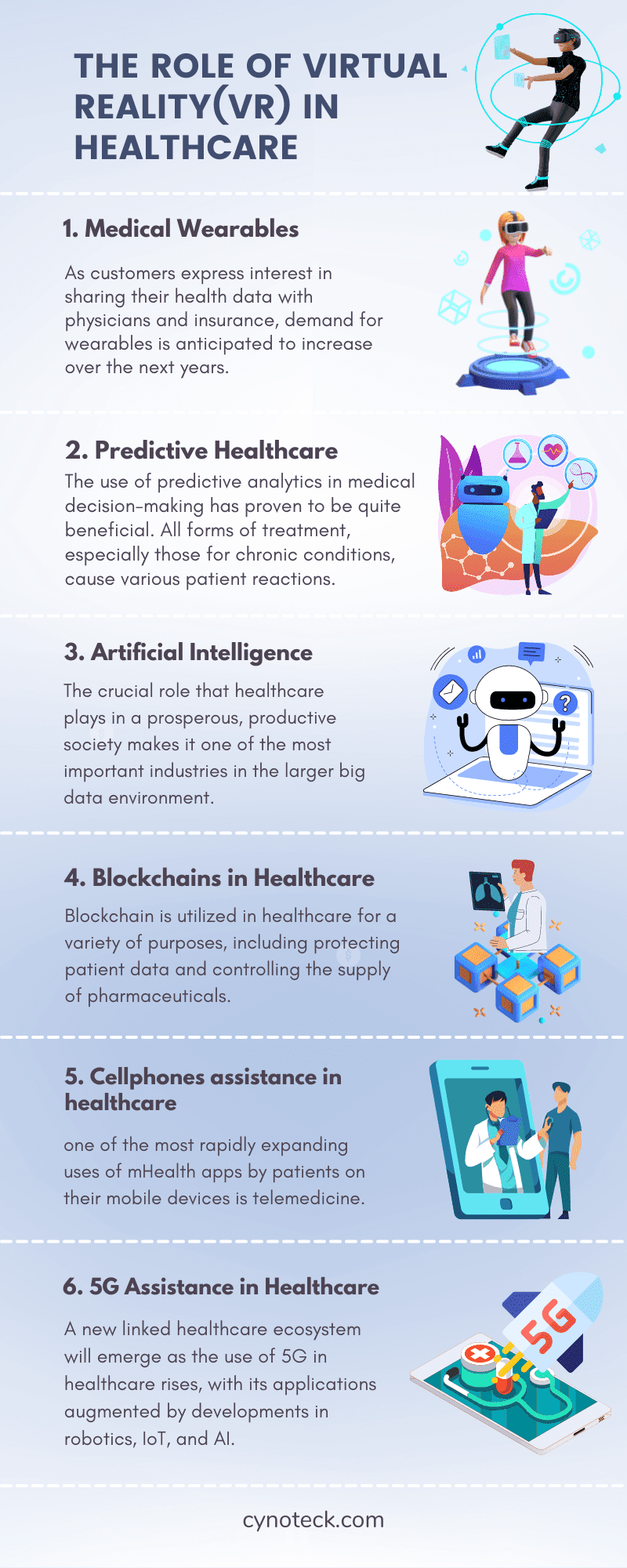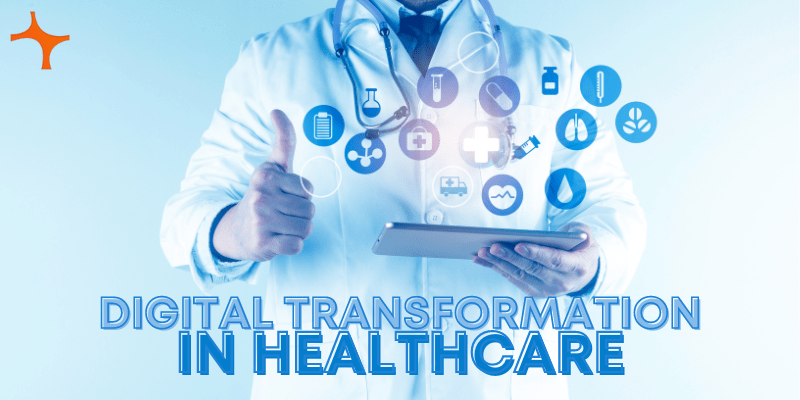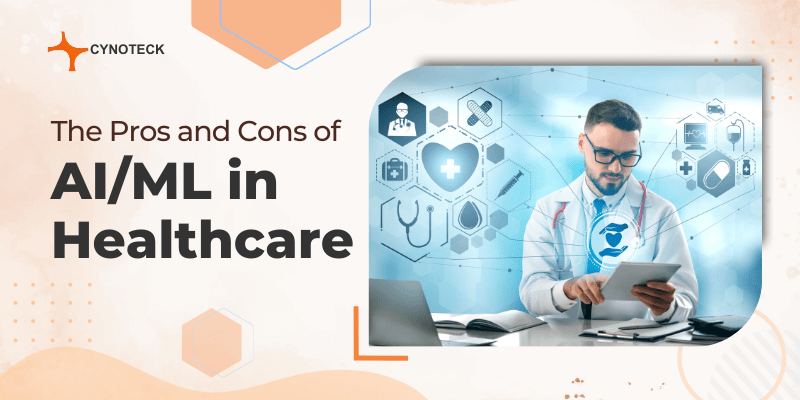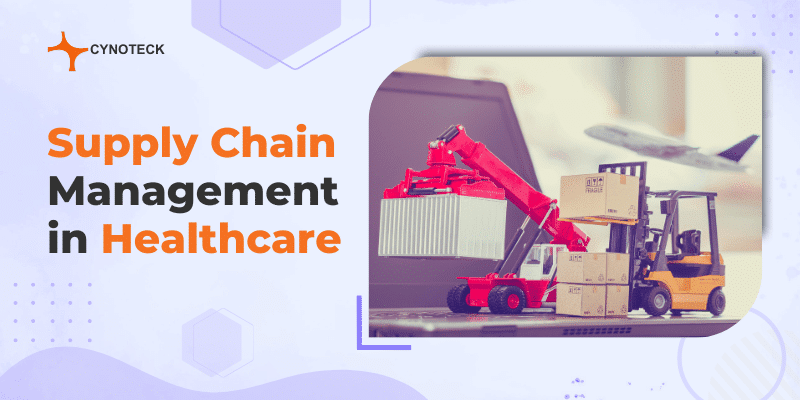In recent years, digital transformation in healthcare has boomed to its advancement. We’ve seen a steady progression in medical evolutions before the advent of COVID-19. But as soon as the pandemic hit the globe the need for digital transformation was at its peak. Even after the Covid era, medical advancement is on the run toward digital transformation. The recession is taking over in 2023 still it does not hinder the growing demand for digital transformation in healthcare.
Healthcare providers are implementing digital transformation as constant learning to achieve supportable digital transformation benefits. Below we have explained in detail the growing trends and demands of the healthcare digital transformation:
What is digital transformation in healthcare?
Now, let us first understand what comprises digital transformation in healthcare. People have started utilizing digital assets in the healthcare industry as a result of the recent trend of digital transformation.
It involves integrating digital technologies into all facets of the healthcare industry, including member interactions, payer operations, and provider operations.
It also provides increased business agility, which enhances operational excellence, the patient experience, and lowers costs. It is more of a cultural transformation.
The requirement for value-based treatment is driving a significant movement toward digital transformation in the healthcare sector.
The goal of digital transformation is to have a significant, beneficial influence on a patient’s health and quality of life.
Also, read: Future of Mobile Technology in Healthcare
Why do patients want healthcare customization?
Demand for customized, patient-centered treatment has grown as a result of the data-driven healthcare environment.
In fact, according to a recent survey, 72% of patients said they desire more individualized care that is specially designed to meet their unique clinical needs. The majority of patients think technology is the solution.
This research was conducted to look at the real-world uses of personalization in discharge planning in order to better understand how it could enhance healthcare outcomes and customer experience.
This study also looked at how engagement after discharge might cut back on needless medical expenses and readmissions.
This study expands on previous research from the past two decades that suggests that transitions in care and assisted discharge programs following an acute exacerbation can lower needless readmissions.
Better outcomes might be attained with good follow-up treatment, which includes ensuring medication compliance, adherence to the proper rehabilitative and physical therapy, remote symptom monitoring, and prompt follow-up exams.
A patient is more likely to require extra care or wind up back in the hospital when this follow-up care fails (for instance, because of a lack of access, a lack of health literacy, or other factors).
Also, read: How to Develop a Healthcare App in 2023?
Why big data is extremely important in the healthcare industry?
The amount of data that is routinely generated and collected in practically everything, including human understanding, analysis, and usage of technology, has significantly increased during the past ten years.
The discipline of “Big Data” has emerged as a result of these tendencies together. And in the brief period since its origin, big data has truly taken the world by storm, having a profound impact on every industry, from marketing to healthcare, in a variety of ways, boosting productivity, enhancing the efficiency of processes, and fostering an environment that fosters innovation.
Big Data has been found extensively useful in the healthcare sector to predict epidemics, treat disease, enhance life quality, and prevent avoidable deaths, helping to increase profitability and reduce unnecessary overhead.
The medical and healthcare industries have had to fast evolve and adapt to deal with modern forms of treatment administration and transmission as the world’s population continues to grow, quality of life has improved significantly, and people are living longer.
Data is what informs the decisions that are made as a result of these adjustments. Now, the main priority is to fully comprehend the patient as early in life as possible and, ideally, identify any early indicators of a major condition that would facilitate treatment.
The types and volumes of data sources that are accessible for study and analysis have started to increase at the same rate as technology’s influence over the healthcare industry.
In order to gain more specialized knowledge and insights into the world of healthcare, big data solutions aim to harness these enormous, complicated buckets of data. Big Data makes an effort to make sense of this information overflow and offer more insightful analysis from the growing data sources and quantities.
Its current goal is to provide real-time answers to clinical, operational, and financial problems. Big data, according to experts, gives scientists, medical professionals, and management the potential to make well-informed decisions that can save lives, save costs, and increase operational efficiency.
It has the power to completely transform time-consuming operations like how healthcare professionals collect, store, and transfer patient data.
Transform Healthcare with Digital Solutions.
Improve patient care and streamline operations.
Here’s a better look at the state of digital transformation in healthcare in 2023:
The benefits of Virtual Reality(VR) in Healthcare
For many healthcare applications, such as diagnosing patients virtually or giving students and doctors virtual medical training, computer-generated technology is used in virtual reality.
The regulations and culture of the healthcare sector are not immediately accustomed to virtual reality. This does not, however, stop the creation of fresh virtual reality experiences. In real-time or over an extended length of time, VR intends to assist patients in communicating and enhancing their quality of life. One should combine technology with prescription drugs, other forms of therapy, and treatments to accomplish this.
The healthcare industry has benefited surprisingly from this new generation of VR technology, which has the potential to revolutionize medicine in the years to come:
- Virtual reality medical training: VR technology has been warmly received by the medical industry, and it is now an important instrument that training institutions may use to help students become future medical professionals.
- Preventive medicine: Researchers are employing VR technology to help develop treatments and medications by analyzing diseases and medications. A researcher can conduct experiments in virtual reality without putting anyone at risk. Through simulation and computer programs, they may also work at the micro level, allowing them to observe how illnesses behave on the tiniest scales possible.
- Entertaining and calming patients: While you wait to be released from the hospital and go home, time can seem to pass very slowly. You miss your loved ones and friends, and you probably worry about your health. Some hospitals in the US have implemented VR to help patients deal with their boredom and stress. A patient can leave the limitations of the medical ward by donning VR goggles and exploring an incredible virtual world. The alleviation of tension and pain may help in the healing process.
- Beating phobias: VR’s ability to effectively dupe the brain into thinking that what you’re seeing is real can be used to help people beat their fears. Experiments on people suffering from a fear of heights have been successful and trials to help people beat their fear of spiders and other animals have also shown promising results.
The potential medical benefits of virtual reality are vast and, as the technology is always improving, it could soon be adapted even further to treat a whole range of conditions.

Medical Wearables
Devices like FitBits and smartwatches are now considered commonplace since wearable fitness technology has made such a large place for itself in the healthcare sector. Due to customers’ growing interest in tracking their own health and vital signs, the use of wearable technology has more than tripled in the previous four years.
As customers express interest in sharing their health data with physicians and insurance, demand for wearables is anticipated to increase over the next years.
According to an estimate made by Insider Intelligence in October 2021, the US smart wearable user market is expected to increase by 25.5% YoY in 2023, up from a growth rate of 23.3% YoY in 2021.
Predictive Healthcare
An innovative strategy for enhancing patient outcomes is predictive analytics. Machine learning algorithms can be programmed to provide insight into the types of treatments that will be most effective for the current patients by looking at data and outcomes of previous patients.
Predictive analytics can also be used to spot warning indications before they became serious. As the COVID-19 epidemic dominates healthcare, researchers are investing time and money in creating predictive analytic strategies to fight the virus.
The use of predictive analytics in medical decision-making has proven to be quite beneficial. All forms of treatment, especially those for chronic conditions, cause various patient reactions.
Researchers at the University of Michigan Rogel Cancer Center are developing a blood test that can determine months before normal imaging scans whether a particular treatment regimen for HPV-positive throat cancer is effective.
Artificial Intelligence
Artificial Intelligence is referred to the use of machine learning (ML) algorithms and other cognitive technologies in healthcare.
AI can be defined simply as the ability of computers and other devices to replicate human cognition and to learn, think, and make decisions or take actions.
It refers to the application of machines to analyze and act on medical data, frequently with the aim of forecasting a specific outcome.
The crucial role that healthcare plays in a prosperous, productive society makes it one of the most important industries in the larger big data environment. The use of AI in the healthcare industry can literally mean the difference between life and death.
AI can help healthcare professionals including doctors, nurses, and others with their regular tasks. It can improve patient outcomes overall, improve preventative care and quality of life, and create more precise diagnosis and treatment strategies.
By examining data from the public sector, the healthcare industry, and other sources, AI can help forecast and monitor the development of contagious diseases.
As a result, AI has the potential to be a key component of the global public health effort in the fight against pandemics and epidemics.
Also, read: How is AI in Healthcare revolutionizing the Healthcare Industry?
Blockchains in Healthcare
Blockchain is utilized in healthcare for a variety of purposes, including protecting patient data and controlling the supply of pharmaceuticals.
In 2020, the United States spent a record-high 20% of its GDP on healthcare.
Consider the fact that the industry is still beset by high hospital expenses, ineffective procedures, and frequent data breaches if that statistic wasn’t startling enough. The need for improved efficiency and innovation is being sparked by these extremely expensive problems.
Team resources are depleted, and patient care is delayed as a result of the laborious procedure of gaining access to a patient’s medical information. Medical records built on the blockchain provide a remedy for these ailments.
The technology’s decentralized structure creates a single ecosystem of patient data that can be efficiently consulted by physicians, medical facilities, pharmacists, and everyone else involved in treatment.
This is how the blockchain can result in more accurate diagnoses and individualized treatment strategies.
Cellphones assistance in healthcare
Mobile health technology, as opposed to a conventional and ineffective telephone connection to doctors and healthcare organizations, allows patients to instantly send secure messages, make appointments, and connect to clinicians 24/7 for telemedicine visits.
In fact, one of the most rapidly expanding uses of mHealth apps by patients on their mobile devices is telemedicine.
They adore how easy it is to communicate with a provider through their phone or tablet, as well as how there is no need for them to leave their jobs or travel to the doctor’s office.
In response to the increase in demand, the majority of health systems now provide telemedicine consultations provided by network physicians as well as contracted telehealth physicians after business hours and on weekends.
5G Assistance in Healthcare
The spread of the coronavirus has placed unprecedented strain on healthcare systems all around the globe, making the potential transformation and improvement of 5G networks relevant today.
A new health ecosystem that can effectively, easily, affordably, and at a sizeable scale address the demands of patients and providers will be made possible by 5G, which promises to deliver the necessary levels of connection.
However, network security and data privacy are crucial to maximizing the promise of 5G networks in healthcare settings.
A new linked healthcare ecosystem will emerge as the use of 5G in healthcare rises, with its applications augmented by developments in robotics, IoT, and AI.
This ecosystem will, in our opinion, be predictive, preventative, individualized, and participatory, which is a relatively new concept known as 4P medicine.
Also, read: Internet of Medical Things – Top Opportunities to Grow your Healthcare Business
How Digital Transformation is Currently Implemented in Healthcare?

Healthcare Automation
Automation in healthcare refers to the use of specific software to increase efficiency across a range of medical service components. This promotes using contemporary methods and equipment for both productivity and capability reasons. Automation is redefining the healthcare sector by enabling efficiency levels that are not possible with manual processes.
Healthcare executives are aware of how well automation works.
According to the healthcare industry, research group CAQH explains that the sector has cut administrative expenses by $122 billion as a result of automation and may save an additional $16 billion by fully automating some routine processes.
As they are tasked with reducing costs, enhancing service quality, and employing data analysis to support decision-making, new healthcare administrators will probably have automation in healthcare as their first duty.
The ways in which this can be done vary, but some examples include enhancing patient satisfaction, enhancing medical procedures, and incorporating technology by advancing the healthcare system into the future.
With the help of contemporary technology, a lot of data may be created and stored while still performing well in both administrative and operational tasks.
Also, read: Artificial Intelligence in Healthcare: The best way to beat the competition in 2021
Common Ambulance
An ambulance that has telemedicine capabilities, sensors, GPS, and other cutting-edge communication and monitoring systems is referred to as a connected ambulance. These technologies can be used to give healthcare professionals real-time information on a patient’s status, allowing them to make educated decisions about the patient’s care.
In order to better coordinate care and exchange information, connected ambulances can improve communication between the ambulance crew and medical professionals.
The efficiency and efficacy of emergency care might be greatly enhanced by networked ambulances, which would eventually improve patient outcomes and experiences.
On-demand healthcare
Patients use on-demand healthcare apps on their mobile devices to instantaneously and immediately access online healthcare services.
These healthcare services can include scheduling appointments or arrange anytime, anywhere video chats with their doctors.
Any on-demand healthcare app can let users get medical services whenever and wherever they are, quickly and efficiently, using their mobile devices, regardless of the application’s purpose or nature.
Using predictive analytics, healthcare organizations are attempting to improve patient outcomes. Technology developments have strongly encouraged data-driven innovation and reasoned decision-making in the healthcare sector.
Healthcare organizations can forecast which illnesses and diseases will cause significant difficulties in the future by combining big data, predictive analytics, and informatics.
Physicians can now estimate patients’ future requirements more accurately by merging vast volumes of medical data with sophisticated algorithms and predictive models.
In this manner, on-demand healthcare applications can make medical services always accessible, which is why they are so important and useful for contemporary healthcare institutions and systems around the world.
Due to this phenomenon, patients may be able to read doctor reviews and ratings as well as have a doctor come to their home faster than they could before the advent of on-demand healthcare apps.
We have a new trend on the horizon when we combine this with people’s passion for having what they want when they want it.
Patient Portals
A patient portal is a safe online platform that provides simple, round-the-clock access to personal health data for patients from any location with an Internet connection. Patients can view health data by entering a secure username and password.
You can reach your provider’s office and access your private personal health information whenever you choose. Basic problems can be fixed without waiting for office hours or phone calls to be returned.
All of your personal health information from all of your providers is accessible in one location. They can all submit results and reminders via a portal if you work with a team of providers or see specialists on a frequent basis.
Your additional treatments and recommendations are visible to your providers. This results in better treatment and medication administration.
You can remember things like annual physicals and flu shots with the aid of email notifications and reminders.
Disease History Analysis
Analyzing a patient’s medical history to comprehend their past and present health disorders and to spot potential red flags for future health issues is known as disease history analysis.
This can be done for a number of reasons, such as making a diagnosis, creating a treatment plan, and determining the risk that particular illnesses will manifest in the future.
Through digital transformation in healthcare, disease history analysis can help medical professionals to determine any patient’s history within a few minutes. The minimum time consumption can save many lives as during critical times every second counts.
Also, read: Salesforce as a Healthcare CRM: Reasons Why Healthcare Providers Should Use It
Cynoteck assistance on Healthcare
Cynoteck has experience working in the healthcare industry across various countries. The healthcare sector includes all businesses that provide medical insurance, and medical services, manufacture medical equipment, provide drugs, or promote the provision of healthcare to patients.
With our niche in the Healthcare industries, Cynoteck has a unique combination of expertise in both service and maintenance – which gives us the capability to deliver best practices with an unmatched depth of understanding.
We have a team of dedicated individuals who will provide not only for your requirements but also provide a unique training program written by our experts about the current and future challenges faced by the healthcare industry.
We become a trusted advisor for your business to whom you come for direction, market intelligence, and support.
Transform Healthcare with Digital Solutions.
Improve patient care and streamline operations.
Conclusion
As the time approaches ahead, more and better medical transformations will occur. The digital transformation domain will make breakthrough advancements. For businesses, it is crucially important to know the key trends of what the market demands. This above list of points helps you to understand and apply ongoing trends in the medical domain.
Also, read: Top Benefits of Using Dynamics 365 Business Central for the Healthcare Industry
Frequently Asked Questions:
Cloud migration is one of the digital trends in healthcare that is relatively easy to implement and start using instantaneously.
Trends in telehealth in the healthcare sector show that telemedicine is the first sector to test new technologies as the online development market shifts and becomes an essential component of healthcare.
In the future, AI and ML will keep enhancing and we’ll see more predictive analytics in healthcare. These technological advancements are useful, constantly-evolving tools that can help patients make potentially life-saving predictions.
In order for health systems to provide high-quality, reasonably priced, and equally distributed treatment, digital health can help them become more sustainable and efficient.
Quick and timely response and treatment can save not only health but also money for any individual. With the use of technological devices and algorithms, the whole process becomes much more convenient for all to use.

CRM Consulting services
Do you want to implement a CRM system within your organization? Connect with our CRM Experts today!




